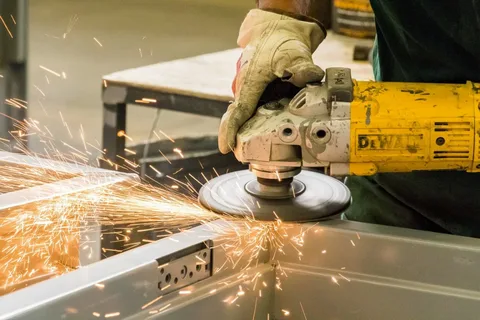Metal fabrication is a cornerstone of manufacturing and construction, encompassing various processes to transform raw metal materials into finished products. Achieving efficiency in metal fabrication requires a combination of skills, knowledge, and high-quality tools. This article explores the essential tools and equipment that make metal fabrication more efficient and effective.
Cutting Tools for Precise Shaping
Cutting is one of the first steps in the metal fabrication process. Tools like plasma cutters, angle grinders, and metal shears are indispensable for achieving precise shapes. Plasma cutters, which utilize high-temperature plasma to slice through metal, offer accuracy and speed, especially for thick materials. Angle grinders, on the other hand, are versatile and allow for cutting, grinding, and polishing, making them a must-have for any metal fabrication project.
In addition to power tools, manual cutting tools like hand shears and hacksaws remain valuable for smaller or more detailed tasks. Modern CNC cutting machines have further revolutionized the industry by allowing fabricators to achieve intricate designs with computer-aided precision. Investing in high-quality cutting tools ensures cleaner cuts, minimizes waste, and improves overall productivity.
Welding Equipment for Durable Joints
Welding is a critical aspect of metal fabrication, ensuring that various components are securely joined. Tools like MIG welders, TIG welders, and stick welders cater to different materials and fabrication requirements. MIG welders are favored for their efficiency and ease of use, making them ideal for large-scale projects. TIG welders, known for precision and clean welds, are perfect for detailed or aesthetic work, especially on stainless steel and aluminum.
Supporting equipment such as welding clamps, helmets, and gloves is equally important for safe and efficient operations. Advances in technology have introduced automated welding systems that increase precision while reducing manual labor. Regardless of the project size, having reliable welding equipment ensures the structural integrity and longevity of fabricated products.
Forming Tools for Custom Shapes
Forming tools play a pivotal role in shaping metal into the desired forms. Equipment like hydraulic press brakes, rollers, and bending machines allow fabricators to create custom angles, curves, and shapes. Hydraulic press brakes are especially effective for bending large metal sheets with precision, while rollers are indispensable for crafting cylindrical or curved pieces.
For smaller projects, hand tools such as hammers, mallets, and bench vises are still relevant for fine-tuning shapes and details. Advanced forming tools integrated with CNC technology provide fabricators with enhanced accuracy and repeatability. Proper forming equipment not only improves the aesthetics of the product but also enhances its functionality by ensuring perfect fits and finishes.
Measuring and Layout Tools for Accuracy
Accuracy is paramount in metal fabrication, and proper measuring and layout tools are essential for maintaining precision. Tools like calipers, tape measures, protractors, and combination squares ensure that dimensions and angles are exact. For more advanced needs, laser measuring tools and digital calipers offer higher accuracy and efficiency.
Marking tools, including scribers and layout dyes, aid in creating guidelines on metal surfaces, reducing errors during cutting or drilling. A well-organized fabrication shop also uses templates and jigs to standardize repetitive processes. By prioritizing accurate measurements and layouts, fabricators can reduce waste, streamline production, and enhance the quality of the finished product.
Finishing Tools for Professional Results
The final stage of metal fabrication involves finishing, which enhances the product’s appearance and functionality. Tools such as grinders, sanders, and polishers are vital for smoothing edges, removing imperfections, and achieving a polished surface. Belt sanders are particularly useful for flat surfaces, while orbital sanders provide finer finishing for detailed areas.
In addition to sanding and polishing tools, paint sprayers and powder coating systems are often employed for adding protective layers and aesthetic appeal. Vibratory tumblers and deburring tools further help in eliminating sharp edges and refining surfaces. The right finishing tools ensure that fabricated metal products are not only functional but also visually appealing and long-lasting.
Conclusion
Efficient metal fabrication relies heavily on the right combination of tools and equipment. From cutting and welding to forming, measuring, and finishing, each stage demands specialized tools to achieve precision and productivity. By investing in high-quality equipment and maintaining them properly, fabricators can ensure successful outcomes in every project. The dynamic nature of metal fabrication continues to evolve, with advanced technologies making processes more streamlined and efficient. Adopting these tools and techniques not only enhances output but also establishes a competitive edge in the industry.

